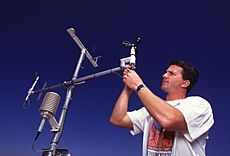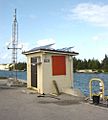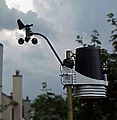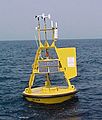Weather station facts for kids
A weather station is a special place or set of tools that helps us understand the weather. It uses different machines to measure things like how fast the wind is blowing, which way it's going, how hot or cold it is, the air pressure, and how much moisture is in the air. These measurements help scientists and forecasters predict what the weather will be like. Many weather stations work all by themselves, sending their information automatically.
Contents
What a Weather Station Measures
Weather stations keep track of several important things about the air around us. Each measurement tells us something different about the current weather conditions.
Wind Speed and Direction
Wind is moving air. Weather stations measure how fast the wind is blowing and the direction it is coming from.
- Wind speed tells us if the wind is a gentle breeze or a strong gust.
- Wind direction tells us if the wind is blowing from the north, south, east, or west.
These measurements are important for understanding weather patterns and for activities like flying planes or sailing boats.
Temperature
Temperature tells us how hot or cold the air is. This is one of the most common weather measurements.
- It helps us decide what clothes to wear.
- It also affects how plants grow and how much energy we use to heat or cool our homes.
Air Pressure
Air pressure is the weight of the air pushing down on the Earth. It's also called barometric pressure.
- Changes in air pressure can tell us if the weather is going to get better or worse.
- High pressure often means clear, sunny skies.
- Low pressure can mean stormy or cloudy weather is on the way.
Humidity
Humidity is the amount of water vapor, or moisture, in the air.
- When humidity is high, the air feels sticky and muggy.
- When it's low, the air feels dry.
Humidity is important for understanding how clouds form and if it might rain or snow.
Tools Used at a Weather Station
Weather stations use special instruments to take their measurements. Each tool is designed to measure a specific part of the weather.
Measuring Air Pressure
- A barometer is the tool used to measure air pressure. It helps forecasters see if high or low pressure systems are moving in.
Measuring Humidity
- A psychrometer is a type of hygrometer. It measures the humidity, or how much moisture is in the air. This helps predict things like fog or rain.
Measuring Wind Speed
- An anemometer is a tool with spinning cups or a propeller. It measures how fast the wind is blowing. The faster it spins, the stronger the wind.
Measuring Cloud Cover
- A ceilometer is an electronic device that measures the height of cloud bases and how much of the sky is covered by clouds. This is important for aviation and understanding precipitation.
Automatic Weather Stations
Many weather stations today are automatic. This means they don't need people to be there all the time.
- They collect data using sensors and then send the information automatically to computers.
- This allows for continuous weather monitoring in many different places, even in remote areas.
Images for kids
-
The NOAA weather station at Wake Island harbor measures and transmits data on wind speed, atmospheric pressure, air temperature and tides.
-
Weather buoy operated by the NOAA National Data Buoy Center
See also
 In Spanish: Estación meteorológica para niños
In Spanish: Estación meteorológica para niños






